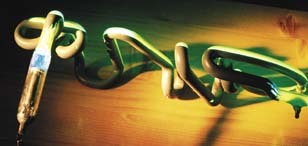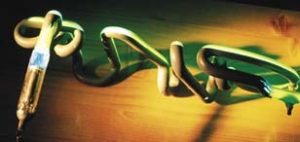Neon usage worldwide is diverse due to differing electrical regulations, materials and fabrication techniques. This month, I’ll examine such differences in Europe and the Far East.
Traditional techniques
Although Europe is small compared to the United States, its neon-sign techniques are more bountiful, but also traditionally based.
One aspect of traditional thinking is having different interpretations for the same product. For example, in the United States and the Arab world, "cold cathode" has traditionally been a term used to imply high-quality lighting products, whereas "neon" refers to cheap luminous advertising. Both products are identical, except for their size. In Europe, this difference doesn’t exist, and the double terminology is unknown.
Neon, being a French invention (see ST, December 2001, page 20) and having spread around the world quickly, was kept in a closed, tightly organized society for decades. Knowledge was passed down from grandfather to father to son, and there was little opportunity to learn different techniques from abroad — no one was willing to share his secrets. Today, local tradition still rules the neon business in many parts of the world.
Tool types
Advertisement
Traditionally, different glassworking tools have been used for the typical, American glassworking style, which features the glass tube being bent in a radius to achieve rounded corners (Fig. 1).
For example, the freestanding "crossfire" burner is used only in the United States. The Dutch use a bench-mounted, gas/air/oxygen cannon torch (like those used worldwide by scientific glassblowers) to achieve the same results. The Italians, in addition to the bench torch, use a gas/air-fired, singe-point handtorch. And the Japanese do all work in a bench-mounted, single-flame torch pointing straight up. $image1
In contrast, a typical German or British neon sign shows sharp glass corners, making the tube look like it was cut at a 45° angle and welded back together (Fig. 2). Sometimes called "miter" bends, these bends are made in a single heat from one straight stick of glass tubing with a single-point hand torch — no cutting, welding or splicing is involved. $image2
Glass types
Not only do working techniques vary worldwide, but so do materials — especially glass. Today, more than 40,000 different types of technical glass are known. Of these, lead glass is the most popular glass used for neon signmaking and is used worldwide, with the exception of a few European and former Soviet Union countries.
In Russia, Poland, Germany and the Netherlands, sodalime glass is primarily used to make neon tubing. This glass type is more difficult to work with because it has a higher softening point and rapidly liquefies, requiring more skill from the glassworker, especially when manipulating large tube diameters.
Advertisement
Because of its wide-working-temperature range, lead glass is easy to bend. However, this glass contains up to 21% lead oxide, which is considered hazardous waste in some municipalities.
Several years ago, a joint venture company formed by OSRAM and Philips developed a glass type with melting and sealing characteristics equivalent to lead glass. This glass, which contains barium and strontium oxides, is sold under different names as "lead-free lead glass" and has replaced lead glass in many parts of the sign and lighting industries worldwide.
The type of glass used in France, parts of Switzerland and Spain differs fundamentally from glass found elsewhere in the world. Pyrex® (or borosilicate) glass, a "hard" glass, is used primarily in chemical-laboratory glasswork. Borosilicate glass has a higher tensile strength than lead glass, but it also has a higher melting point, which requires using oxygen in the torches to achieve a higher flame temperature.
Contrary to some beliefs, borosilicate glasswork must be annealed. If not done properly, the glass accumulates stress and can crack later when the tube is installed in the sign. Also, because borosilicate glass requires special electrodes, unavailable in tubulated form, side-tubulation is necessary.
Due to a reduced resistance to harsh temperature changes, borosilicate glass is also used in some cases for mold-assisted bending of mass-produced beer signs, where the gain in speed outweighs the higher material cost.
Despite the different types of clear glass used for pastel colors, when creating saturated neon colors, the whole world uses one common type of colored glass tubing (available in about eight colors) made from a soft, venetian, sodalime glass base.
Advertisement
Coating techniques
The tube manufacturer or supplier usually applies the fluorescent powder to the inside of neon glass tubing. This is common practice worldwide, except in the Netherlands and Germany, where the glass is shaped first and then the coating is applied.
Although the Netherlands and Germany are neighbors, their coating techniques differ. In Germany, the dry- or dust-coating process is standard; powder is applied in dry form onto a bent glass tube. To make the powder adhere to the inner surface of the glass tube, prior to powder application, an acid binder is applied to etch the glass and make it sticky. The achieved coating is uniform up to the furthest corners (Fig. 2).
In the distinct Dutch or Philips suspension process, the fluorescent powder is mixed with an organic binder and solvent, then the mix is poured into the bent tube. During draining, a thin layer of suspension will stay on the surface; the solvent is dried with warm air face up so that the surplus suspension settles on the tube’s backside. The binder must be baked in an oven while simultaneously sintering the powder into the glass surface to create strong adhesion.
Installation techniques
Neon is installed quite differently around the globe. In Europe, the secondary ground-fault protection (SGFP) has been required for more than a decade. However, in the United States, the UL 2161 standard was adopted into local electrical codes only within the past few years. In the Far East, electronic power supplies are used more frequently than in the United States.
Wiring methods in rural areas, especially in South America and Asia, are grassroots — often bare wire is suspended from glass standoffs. When done properly, this metal-glass-porcelain construction is more reliable than any polymeric insulation, excluding silicone.
Because local electrical codes vary widely, it’s always best to know what’s legal before you start assembling. Being UL-listed, for example, doesn’t necessarily mean "legal" in Europe. And the CE mark doesn’t imply that all necessary rules have been observed; rather, it indicates that a manufacturer’s products conform to whatever European regulations the manufacturer or distributor considers applicable.
Different cultural evolutions and material availability affect neon techniques worldwide. However, the physics of a neon tube is universally known, as is the warm touch of colorful light handcrafted directly from molten glass — something no other sign medium can replace.



 Tip Sheet1 week ago
Tip Sheet1 week ago
 Ask Signs of the Times2 days ago
Ask Signs of the Times2 days ago
 Real Deal1 week ago
Real Deal1 week ago
 Benchmarks5 days ago
Benchmarks5 days ago
 Editor's Note2 weeks ago
Editor's Note2 weeks ago
 Women in Signs1 week ago
Women in Signs1 week ago
 Photo Gallery7 days ago
Photo Gallery7 days ago
 Women in Signs1 week ago
Women in Signs1 week ago











